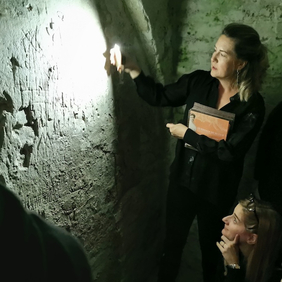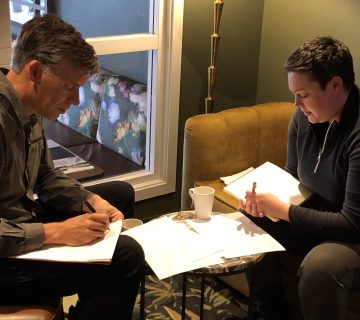Robbie Robertson once said: ‘You don’t stumble upon your heritage. It’s there, just waiting to be explored and shared’. This quote was probably followed by most of the 20 participants – future trainers – who met each other at Osijek, an old Croatian city on the Drava river, which dates to Neolithic times. Thanks to our host, Jesenka Ricl (CIG and museum educator) and the Museum of Slavonia staff, 20 of us from Croatia, Slovenia, Bulgaria and Ukraine felt very comfortable and inspired during the two-day Certified Interpretive Trainer (CIT) course and one-day CIG/CIW upgrade workshops. Our mentors for three days were Valya Stergioti, IE’s Training Coordinator, and Thorsten Ludwig, IE Managing Director, who trained us in the last step to become future IE trainers for Certified Interpretive Guides and Certified Interpretive Writers and share their big experience and trainers’ secrets with us.
In the beautiful surroundings of the Slavonian Museum and the old town of Osijek, we discovered not only the ‘sense of place’, but also renewed and developed our knowledge of the interpretive triangle, values and frames, and discussed the role of values. We also learned about the qualities of IE’s training, education paradigms, brain rules, share zone and everything about a partner organisation for understanding the need and the process of a partnership in organising IE courses and events. We checked out how CIT can contribute to IE goals, what motivates us, what is a managing crisis, how to select the participants, the certification process for guides and trainers and the qualities of a CIT.
During the course, we discussed, analysed, suggested and learnt to argue our point of view. Unlike the CIG and CIW courses, we received more theory and much more discussion than doing exercises, but this is the real trainer’s life behind the scenes of the courses. In addition, the programme was perfectly organised, so we had a little time to stroll through the city and happily see a flock of cranes.
On the final day, on the upgrading course, we focused on exercises and the practical part of CIG and CIW courses. It was a huge experience for future IE trainers to communicate with present IE trainers via Skype as well as to hear Valya and Thorsten’s personal experiences as trainers. Jesenka, our host and expert museum educator, showed and interpreted to us the former prison in the basement of the museum of Slavonia as well as clothes and fashion accessories from Rococo to Art Nouveau times as a part of an exhibition of the Split city museum in Osijek.
We also should mention the great time spent together at the end of the day in the incredible surroundings of the pre-Advent old town of Osijek, with traditional Slavonian restaurants and bars. There we shared our experiences, which is one of the main principles of IE.
Igor Ianachi is the manager of a small hotel in Tribunj (Croatia) and founder of Sibeniktour.com. You can get in touch with him at sibeniktour@gmail.com.
Tetiana Karpiuk is a freelance interpretive guide and project officer for WWF Ukraine. She can be contact at: tan.karpiuk@gmail.com.
To cite this article:
Ianachi, Karpiuk (2019) ‘Looking for the partners: The first CIT course in Croatia’. In Interpret Europe Newsletter 4-2019, 14.
Available online: www.interpret-europe.net/fileadmin/Documents/publications/Newsletters/ie-newsletter_2019-4_winter.pdf




